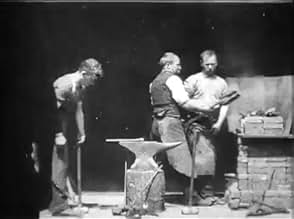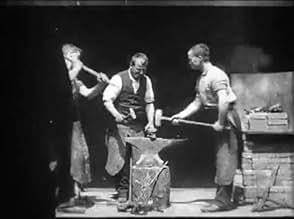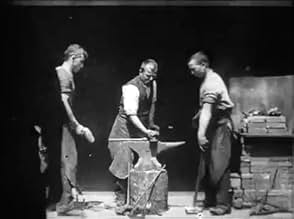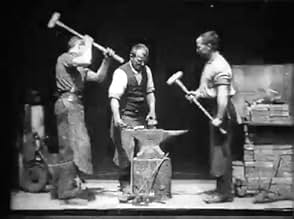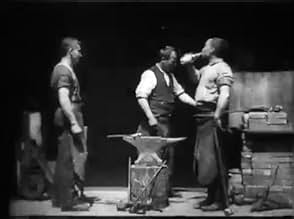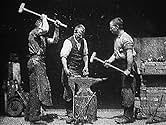IMDb-BEWERTUNG
6,2/10
2969
IHRE BEWERTUNG
Füge eine Handlung in deiner Sprache hinzuThree men hammer on an anvil and pass a bottle of beer around.Three men hammer on an anvil and pass a bottle of beer around.Three men hammer on an anvil and pass a bottle of beer around.
- Regie
- Hauptbesetzung
- Auszeichnungen
- 1 wins total
Charles Kayser
- Blacksmith
- (Nicht genannt)
Empfohlene Bewertungen
'Blacksmith Scene (1893)' was one of the first commercially-exhibited motion pictures, filmed in April 1893 and first screened publicly at the Brooklyn Institute on May 9, 1893. The set-up is pretty simple: three blacksmiths (actually employees of Thomas Edison) start hammering away at a heated metal rod and an anvil, before pausing to pass around a bottle of beer. The acting from two of the performers is convincing enough; the third blacksmith, on the left, doesn't even pretend that the beer bottle contains any liquid, briefly pressing the rim to his mouth and then removing it without even the pretence of drinking. The film's first seven seconds have the silhouette of a fourth party blocking the left side of the frame, before somebody presumably told him to get out of the way. While watching this didn't give me the same thrill as the Lumière brothers' 'Arrival of a Train at La Ciotat (1895),' 'Blacksmith Scene' is still an important historical curiosity. I'm grateful that the National Film Registry always remembers to honour and preserve even these apparently-innocuous snippets of cinema history.
The Black Maria movie studio at Edison's West Orange, New Jersey laboratory (see comments on "Men Boxing" for a description) was used, from 1892 until 1900, to produce as many as 300 films. "Blacksmith Scene" was filmed in this studio and is generally regarded as the earliest known commercial film. It was filmed by the vertical-feed Kinetograph camera using 1-1/2-inch celluloid film newly developed by the Eastman Company.
To make this film 'commercial', it was necessary to have a way for the public to view it. A Kinetoscope was developed for that purpose. The Kinetoscope (a peep-show machine) was used for a public exhibition; given at a meeting of the Brooklyn Institute of Arts and Sciences on Tuesday May 9th, 1893. Over 400 people lined up to view the film over a two hour period.
To make this film 'commercial', it was necessary to have a way for the public to view it. A Kinetoscope was developed for that purpose. The Kinetoscope (a peep-show machine) was used for a public exhibition; given at a meeting of the Brooklyn Institute of Arts and Sciences on Tuesday May 9th, 1893. Over 400 people lined up to view the film over a two hour period.
The footage in this very early movie still looks very good, and it still works as a vignette (albeit a staged one) of life in a bygone era. In itself, it's a simple scene, but it's far from a lifeless one, and the composition works as well.
The scene, which features the leisurely-paced efforts of the blacksmiths as they do their work while occasionally refreshing themselves, is not without a little irony. Even in its day, although the blacksmith shop itself was a familiar sight, the laid-back feel of the scene was deliberately imagined as a throwback to an earlier day, rather than as a picture of the (then) present of the 1890s. (The notes in the new Kino collection of Edison films confirm this.) By contrast, many of the other earliest movies were made with a deliberate emphasis on things of the present.
The images still look quite clear in comparison with some of the other experiments in the earlier 1890s, so it must have looked quite good in its time. Then, it was an intriguing taste of things soon to come. Now, it is a chance to revisit the past.
The scene, which features the leisurely-paced efforts of the blacksmiths as they do their work while occasionally refreshing themselves, is not without a little irony. Even in its day, although the blacksmith shop itself was a familiar sight, the laid-back feel of the scene was deliberately imagined as a throwback to an earlier day, rather than as a picture of the (then) present of the 1890s. (The notes in the new Kino collection of Edison films confirm this.) By contrast, many of the other earliest movies were made with a deliberate emphasis on things of the present.
The images still look quite clear in comparison with some of the other experiments in the earlier 1890s, so it must have looked quite good in its time. Then, it was an intriguing taste of things soon to come. Now, it is a chance to revisit the past.
This early movie perfectly demonstrates the future possibilities of motion picture.
The quality of the movie is surprising good looking. There are no jerky movements and the colors are clear to see, as is the entire picture as a whole. Sorts of makes you wonder why movies from the 1910's and '20's were so much worse looking compared to these early Edison Manufacturing Company films, from the end of the 19th century, when it comes down to the visual quality of the images. Of course it has to do everything with different (and cheaper and more simple to make) camera techniques and projecting being used, among other reasons.
The movie shows three hard working blacksmiths hammering on an anvil, one at a time, each on a other side. When they're done they're thirsty and pass a bottle of beer, before resuming their work. Funny to see that the beer bottle itself was obviously empty. The third guy that got the bottle didn't even bothered to do as if he took a sip. He simply putted the bottle against his lips and then quickly putted it back on its place.
It's a studio shot movie (shot at Black Maria studio at West Orange, New Jersey, America's first movie studio, built on the grounds of Edison's laboratories), meaning that the person's are 'actors' (actually of course just Edison employees) and the events are staged. The movie shows all of the possibilities of movie making. It has lots of individual movements from 3 separate persons and 'action' in it, since there are several things happening within the 30 seconds.
I'm sure this movie must have really thrilled people to see all of the possibilities of motion pictures, when it was first publicly shown at the Brooklyn Institute in 1893.
8/10
http://bobafett1138.blogspot.com/
The quality of the movie is surprising good looking. There are no jerky movements and the colors are clear to see, as is the entire picture as a whole. Sorts of makes you wonder why movies from the 1910's and '20's were so much worse looking compared to these early Edison Manufacturing Company films, from the end of the 19th century, when it comes down to the visual quality of the images. Of course it has to do everything with different (and cheaper and more simple to make) camera techniques and projecting being used, among other reasons.
The movie shows three hard working blacksmiths hammering on an anvil, one at a time, each on a other side. When they're done they're thirsty and pass a bottle of beer, before resuming their work. Funny to see that the beer bottle itself was obviously empty. The third guy that got the bottle didn't even bothered to do as if he took a sip. He simply putted the bottle against his lips and then quickly putted it back on its place.
It's a studio shot movie (shot at Black Maria studio at West Orange, New Jersey, America's first movie studio, built on the grounds of Edison's laboratories), meaning that the person's are 'actors' (actually of course just Edison employees) and the events are staged. The movie shows all of the possibilities of movie making. It has lots of individual movements from 3 separate persons and 'action' in it, since there are several things happening within the 30 seconds.
I'm sure this movie must have really thrilled people to see all of the possibilities of motion pictures, when it was first publicly shown at the Brooklyn Institute in 1893.
8/10
http://bobafett1138.blogspot.com/
By the time Dickson and Edison had produced "Blacksmith Scene", the forming of the Edison company was well underway. Within three years (1890-1892) their hopes of creating motion pictures had become realized, beginning with the blurry, incomprehensible tests of the "Monkeyshines" movies to the clear, smoothly moving "Dickson Greeting" of 1891. (I cannot say much for the 1892 films as many of them appear to be lost completely, and the two remaining ones I've viewed are, shall we say, almost as bad as watching the "Monkeyshines" trilogy for whatever reason). Then came 1893, a year in which little filming in the motion picture industry seemed to take place outside of the two Edison movies "Horse Shoeing" and this film. On the other hand, the events of the year were very big: Edison's Black Maria studio was finally completed and the very first public showing of films in America was held in the Brooklyn Institute of Arts and Sciences. Among the two films to be shown at the institute was "Blacksmith Scene", and despite the fact both films were shown the exact same day and both featured a staged scenario, the other one to be shown ("Horse Shoeing") hasn't had much attribution given to it even though it was labelled as "first successful Edison film" on the three surviving stills known to exist. But I digress...
Yet, despite being only 30 seconds long, this single film (or two films, as I prefer to say) shows quite interestingly enough the potential of motion pictures. In filming these three men hammering at the anvil, the idea of filming fictitious action shows us the possibilities of special effects, of dream worlds, of everything we have today. In that sense we can say it was Edison, not Georges Méliès, who showed such possibilities. There are all sorts of clues to show you this is not a documentary film: take, for instance, the black background. Clearly a real blacksmiths shop would have a brick or cement wall instead. Furthermore, check out the brief swig the blacksmith on the left does, showing us that the bottle is probably quite empty since he would have had to tip his neck back further to drink in real life. The silhouette of the man standing in front of the camera is clearly either an assistant cameraman or a director (Dickson, in this case) directing the action, who must have been told he was blocking part of the scene, or have realized it himself as he soon steps out of the way.
As if those two things weren't enough, "Blacksmith Scene" also began a new silent era movie genre that would be copied several other times over the next couple of years. One of the earliest known remakes (but not the first) was the Lumière Brothers' "The Blacksmiths" which was also historically important as being on of the ten movies shown at the Salon Indien in the December of 1895. In the remake, it is clear some of the scenario was staged but shot in a real location with real blacksmiths, and was less important as a result. This was followed soon after by "Blacksmith in His Workshop", a Georges Méliès documentary of 1896. No comparison to that movie can be made, however, as it remains lost.
Yet, despite being only 30 seconds long, this single film (or two films, as I prefer to say) shows quite interestingly enough the potential of motion pictures. In filming these three men hammering at the anvil, the idea of filming fictitious action shows us the possibilities of special effects, of dream worlds, of everything we have today. In that sense we can say it was Edison, not Georges Méliès, who showed such possibilities. There are all sorts of clues to show you this is not a documentary film: take, for instance, the black background. Clearly a real blacksmiths shop would have a brick or cement wall instead. Furthermore, check out the brief swig the blacksmith on the left does, showing us that the bottle is probably quite empty since he would have had to tip his neck back further to drink in real life. The silhouette of the man standing in front of the camera is clearly either an assistant cameraman or a director (Dickson, in this case) directing the action, who must have been told he was blocking part of the scene, or have realized it himself as he soon steps out of the way.
As if those two things weren't enough, "Blacksmith Scene" also began a new silent era movie genre that would be copied several other times over the next couple of years. One of the earliest known remakes (but not the first) was the Lumière Brothers' "The Blacksmiths" which was also historically important as being on of the ten movies shown at the Salon Indien in the December of 1895. In the remake, it is clear some of the scenario was staged but shot in a real location with real blacksmiths, and was less important as a result. This was followed soon after by "Blacksmith in His Workshop", a Georges Méliès documentary of 1896. No comparison to that movie can be made, however, as it remains lost.
Wusstest du schon
- WissenswertesThe mixing of work and alcohol was commonplace in the early 19th century, especially amongst heavy laborers. By the 1890's, however, the practice had died away. The use of the bottle of beer in this film is intended to invoke a sense of comic nostalgia of a bygone era.
- VerbindungenFeatured in Edison: The Invention of the Movies (2005)
Top-Auswahl
Melde dich zum Bewerten an und greife auf die Watchlist für personalisierte Empfehlungen zu.
Details
- Laufzeit
- 1 Min.
- Farbe
- Sound-Mix
- Seitenverhältnis
- 1.33 : 1
Zu dieser Seite beitragen
Bearbeitung vorschlagen oder fehlenden Inhalt hinzufügen

